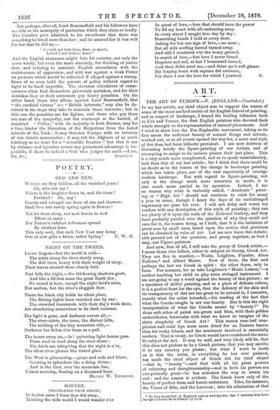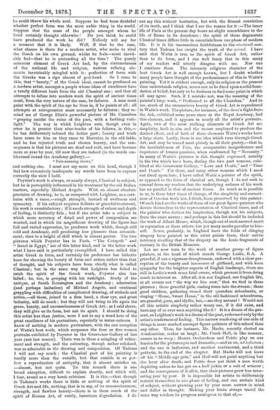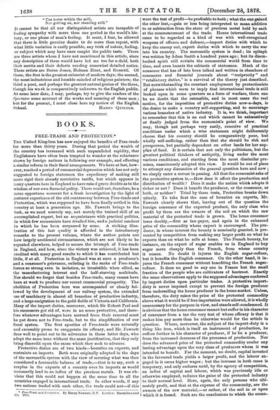ART.
THE ART OF EUROPE.—V. (ENGLAND—Concluded.) IN my last article, my chief object was to suggest the reason of some of the most marked merits of the English School of painting, and in respect of landscape, I traced the leading influence back to Cox and Turner, the first English painters who devoted their- whole strength to the representation of natural phenomena. And I tried to show how the Pre-Raphaelite movement, taking as its first canon the sufficient beauty of natural things and actions,, worked out, or at all events opened the way for, a more real style of Art than had been hitherto prevalent. I am now desirous of discussing briefly the figure-painting of our Artists, and of attempting to assign to its various phases their just place. This is a very much more complicated, and so to speak unsatisfactory, task than that of my last article ; for I think that there could be no doubt as to the reason of the change in landscape painting which has taken place, nor of the vast superiority of average modern landscape. But with regard to figure-painting, not only is the change much more uncertain in merit, it is also much more partial in its operation. Indeed, I see no reason why what is variously called, " Academic " paint- ing or "High Art" should not continue to exist for many a year to come, though I fancy the days of its unchallenged supremacy are gone for ever. I will not delay and weary my readers with any description of this style of painting ; they can_ see plenty of it upon the walls of the National Gallery, and they have probably puzzled over the question of why they could not care for it, the reason being, as I hold, that it is the imitation of great men by small ones, based upon the notion that greatness can be obtained by rules of Art. Let me now leave this debate- able ground out of the question, and group together, as best I may, our Figure-painters.
And now, first of all, I will take the group of Greek artists,— I mean those who follow, either in subject or theory, Greek Art.
They are five in number, — Watts, Leighton, Poynter, Alma.
Tadema,* and Albert Moore. Now of these, the first and perhaps the last are Greek in spirit ; the other three, only in
form. For instance, let UB take Leighton's "Music Lesson,"—a.
mother teaching her child to play some stringed instrument. I am not going to say a word against the beauty of this picture ; as a specimen of skilful painting, and as a piece of delicate colour, it is a perfect feast for the eye, that the delicacy of the skin and its transparency of tint are too great to be natural is, I conceive,.
exactly what the artist intended,—his reading of the fact that what the Greeks sought in art was beauty. But is this the right interpretation of what the Greeks meant by " beauty ?" Do.
these soft robes of palest sea-green and blue, with their golden embroideries, harmonise with what we know or imagine of the stern simplicity of Greek Art ? This waxen rose-leaf com- plexion and coral lips seem more fitted for an Eastern harem than for rocky Ithaca, and the sentiment involved is essentially modern. That is to say, no Greek would have considered the scene fit subject for Art. It may be said, and very likely will be, that this does not profess to be a Greek picture, that you may ascribe it to any country you please ; but what I want to insist on is that the artist, in everything he has ever painted,.
has made the chief object of Greek Art his chief object —that is, "beauty "—and that with all his great powers of colouring and draughtsmanship—and in both his powers are exceptionally great—he has mistaken the way to attain his end ; and the reason is evident. The Greek knew only of the beauty of perfect form and heroic endurance. Take, for instance, the Venus of Milo, and the Laociion ; into his admiration of that • So long domiciled in England, and so well known, that I mention him here. though I believe be is French by birth.
he could throw his whole soul. Suppose he had been doubtful whether perfect form was the most noble thing in the world. Suppose that the mass of the people amongst whom he lived certainly thought otherwise ! Do you think he could have produced the work he did ? Nobody will say for a moment that it is likely. Well, if that be the case, what chance is there for a modern artist, who seeks to rival the Greek on his own ground, whilst he feels—must inevit- ably feel—that he is pretending all the time ? The purely sensuous element of Greek Art bad, by the circumstances of the national life and religion, various refining ele- ments inextricably mingled with it ; perfection of form with the Greeks was a sign almost of god-head. So I come to this, that "beauty," of the Greek ideal, cannot be produced on a modern artist, amongst a people whose ideas of excellence have a totally different basis from the old Classical one ; and that all attempts to infuse into modern work the spirit of ancient times must, from the very nature of the case, be failures. A man must paint with the spirit of the age he lives in, if he paints at all ; all attempts at retrogression must necessarily be failures ; they re- mind me of George Eliot's powerful picture of Mr. Casaubon "groping amidst the ruins of the past, with a farthing rush-
light." The way in which Leighton errs, though even in error he is greater than nine-tenths of his fellows, is this,— he has deliberately refused the better part ; beauty and truth have come to him as they came to Hercules, in the old fable, and he has rejected truth and chosen beauty, and the con- sequence is that his pictures are dead and cold, and have become more so year by year, till now they are indeed (in the words em- blazoned round the Academy gallery),— " Fair-seeming shows," and nothing else. I must not say more on this head, though I feel how excessively inadequate my words have been to express correctly the view I hold.
Poynter's work is always, or nearly always, Classical in subject, but he is perceptibly influenced in his treatment by the old Italian masters, especially Michael Angelo. With an almost absolute precision of drawing, he is, as compared with Leighton, as a cart- horse with a racer,—rough strength, instead of swiftness and symmetry. If his subject requires delicate or graceful treatment, his work is unsatisfactory ; if it needs strength of colour and depth of feeling, it distinctly fails ; but if the artist take a subject in which mere accuracy of detail and power of composition are wanted, and in which his magnificent drawing of the figure has full and varied expression, he produces work which, though still cold and Academic, still producing less pleasure than astonish- ment, rises to a height of skill which is almost genius. The two pictures which Poynter has in Paris, "The Catapult" and "Israel in Egypt," are of this latter kind, and in the latter work what I have said is particularly exemplified. I have called this artist Greek in form, and certainly his preference has hitherto been for showing the beauty of form and action rather than that of thought, and his subjects have been chiefly what is called Classical ; but in the same way that Leighton has failed to catch the spirit of the Greek work, Poynter also has failed ; he, too, is groping with his rushlight. Study of the antique, at South Kensington and the Academy ; admiration (and perhaps imitation) of Michael Angelo, and continual grappling with difficulties of complicated drawing, of attitude and action,—all these, joined to a firm hand, a clear eye, and great industry, will do much ; but they will not bring to life again the grace, beauty, and unconsciousness of Greek Art ; as I said above, they will give us its form, but not its spirit. I should be doing this artist less than justice, were I not to say a word here of the great excellence of his portraiture, especially in water-colours. 1 know of nothing in modern portraiture, with the one exception of Watts's best work, which surpasses the four or five women portraits exhibited by Poynter in the Grosvenor Gallery of last year (not last season). There was in them a mingling of refine- ment and strength, and the colouring, though rather subdued, was as admirable as the drawing and composition. Of Tadema I will not say much ; the Classical part of his painting is hardly more than the outside, but that outside is so per- fect a reproduction of antiquity, that it almost satisfies us, —almost, but not quite. To this remark there is one broad exception, difficult to explain shortly, and which will, I fear, sound as a very harsh criticism: It is this,—that though in Tadema's works there is little or nothing of the spirit of Greek Art and life, nothing, that is to say, of its unconsciousness, strength, and flawless beauty—there is in them much of the spirit of Roman Art, of costly, luxurious degradation. I do
not say this without hesitation, but with the firmest conviction of its truth, and I think that I see the reason for it :—The inner life of Paris at the present day bears no slight resemblance to the life of Rome in its decadence ; the spirit of those degenerate Classical times differs little in essentials from one phase of modern life. It is in his unconscious faithfulness to the nineteenth cen- tury that Tadema has caught the truth of the second. I have said that Watts is true to the spirit of Greek Art, rather than to its form, and I can well fancy that in this many of my readers will utterly disagree with me. Nor can I convince them. The intensely religious character of the best Greek Art is well enough known, but I doubt whether many people have thought of the predominance of this in Watts's painting. Yet it is evident enough, only its religion as the present time understands religion, seems not to be fixed upon a solid foun- dation of belief, but only to be desirous to find some point in which all may agree. Such, if I mistake not, was the meaning of the painter's large work, "Dedicated to all the Churches." And to- me, much of the unconscious beauty of Greek Art is reproduced in Watts's work. The picture, for instance, of the dove's flight from the Ark, exhibited some years since at the Royal Academy, had this element, and it appears in nearly all the artist's portraits. Again, two of the most striking elements of Greek Art are simplicity, both in aim and the means employed to produce the desired effect, and of both of these elements Watts's works have a large share. Lastly, there is one idea which runs through Greek Art, and may be traced most plainly in all their poetry,—that ia the inevitableness of Fate, the comparative insignificance and impotence of human passions, when confronted by "Necessity." In many of Watts's pictures is this thought expressed, notably in the two which have been, during the two past seasons, exhi- bited at the Grosvenor Gallery, "Love and Death," and "Time and Death." For these, and many other reasons which I need not dwell upon here, I have called Watts a painter of the spirit, as opposed to the form of classical art, though I do not seek to conceal from my readers that the underlying sadness of his work has no parallel in that of ancient times. As much as is possible to us, in these later times of change, of the simplicity and earnest- ness of Grecian work has, I think, been preserved by this painter. Of such kind are the works of those of our great figure-painters who devote themselves to the representation of Classical times, and of the painter who derives his inspiration, though not his subjects, from the same source ; and perhaps in this list should be included the work of Albert Moore, which, though not of such assured merit or reputation as these others, has yet many merits peculiar to him- self. Never, probably, in England have the folds of clinging drapery been painted as this artist paints them, their subtle intricacy rivalling that of the drapery on the Ionic fragments of statuary in the British Museum.
Let me now turn to the work of another group of figure painters, at the head of which stands George Leslie, R.A. A graceful, if not a vigorous draughtsman, endowed with a clear per- ception of the beauty and innocence of girlhood, and with keen sympathy for the brighter aspects of English landscape, there are still in Leslie's work some fatal errors, which prevent it from doing much to interest us. After all, it is not England, nor English life, at all events not "the way we live now," that we find in these pictures ; these graceful girls, casting roses into the stream ; these good children, gathering round their quondam schoolmate, or singing "Home, Sweet Home," in the old-fashioned schoolroom, are graceful, pure, and idyllic, but,—are they natural ? Would not, all this artistic simplicity rather weary one, if it did exist, and have any of us ever seen anything like it ? It is a dream of the pre- sent, as Leighton's work is a dream of the past, redeemed only by the artist's tenderness of feeling. This narrow rendering of one side of things is more marked amongst figure-painters of this school than any other. Thus, for instance, Mr. Marks, recently elected an. Academician, makes us laugh ; Mr. Frank loll, in like manner, causes us to weep ; Messrs. Orchards= and Pettie play on our fancies for the picturesque and dramatic,—and so on, ad infinitum ; and the one is ludicrous, and another sentimental, and a third pathetic, to the end of the chapter. But Marks will not leave off his "Middle-age grin," and Roll will not paint anything but the hour after death, and Pettie does not think a man worth depicting unless he has got on a buff jerkin or a suit of armour ;. and the consequence of it all is, that their pictures grow less inter- esting year by year. It is impossible for artists to deliberately restrict themselves to one phase of feeling, and one archaic kind of subject, without growing year by year more narrow in mind. and duller in thought. Making your brain always travel tho same way renders its progress analogous to that of,— "The horse within the mill, Nor getting on, nor standing still."
It cannot be that all our distinguished artists are incapable of feeling sympathy with more than one period in the world's his- tory, or one phase of man's feeling. It must, I fear, be allowed that there is little genuine desire to do more than repeat, with what little variation is easily possible, any trick of colour, feeling, or subject which may have once caught the public taste. There are three artists whom I have not mentioned in this article, since any description of them would have led me too far a-field, both their merits and their defects needing somewhat detailed notice. These artists are Burne Jones, Holman Hunt, and Rossetti. Of these, the first is the greatest colourist of modern days; the second, the most industrious and humble-minded of religious painters; the third a poet, and perhaps the greatest natural genius of the three, though his work is comparatively unknown to the English public. At some later date, I may, perhaps, try to give the readers of the Spectator some account of the works and meaning of these men ; but for the present, I must close here my review of the English




































 Previous page
Previous page